Stop Freezing to Death: The Real RimWorld Cold Survival Playbook
Quick-Start: Warm Clothes in a Hurry 🔥
If you're on the brink of freezing, here's the TL;DR to get your colonists warm fast! New to RimWorld? Start with our complete beginner's guide to learn the fundamentals first.
Build a Heat Source Immediately
Get a campfire or heater going in an enclosed space. A small room with a campfire can hover around 20 °C indoors even if it's below freezing outside. This buys you time and a warm refuge for pawns without proper clothes.
Craft or Grab a Parka ASAP
Parkas are your best friend in cold biomes – they dramatically extend a pawn's safe temperature range (a normal muffalo wool parka can keep a pawn comfy down to about –55 °C!).
Layer Up Whatever You Have
Until you get parkas, layer your colonists with every available clothing slot. That means a shirt + pants + jacket (or duster) + hat.
Use Sleeping Spots by Fires/Geysers
When night falls, make your colonists sleep warm. If you have a steam geyser, consider making a tiny room over it or near it.
Monitor the "Comfortable Temperature" Range
Select a pawn and check their Gear tab – it shows their safe temperature range (e.g. –30 °C to +26 °C). Pay attention to that lower number.
Following these steps should stabilize your colony in the short term.
Early-Game Survival in Cold Biomes 🥶
Early game in a cold biome (think Ice Sheet, Tundra, Boreal Forest in winter) is a race against time and temperature. Your starting survivors often have inadequate clothing – e.g. a tribal start might spawn with just tribalwear, or a crashlanded crew might have one jacket between them. Meanwhile, the first cold snap or winter is looming.
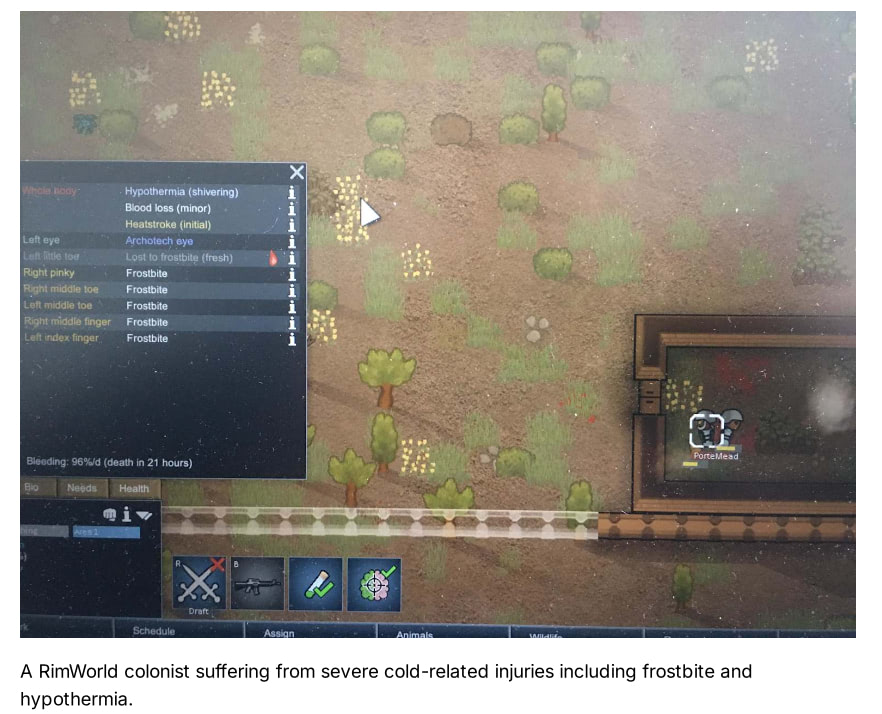
A RimWorld colonist suffering from severe cold-related injuries including frostbite and hypothermia - this is what happens when you don't prepare for the cold!
1. Secure a Warm Shelter
+Before even worrying about parkas, make sure you have at least one heated room. Build a small hut (the smaller, the easier to heat) and get a campfire or heater running inside.
- A single campfire can heat a tiny room by ~20-30°C above outside temp
- Use double walls or an airlock door if it's really cold
- This room will be your colonists' refuge until you have decent clothing
- Helps avoid the mood hit from "Slept in the cold"
For comprehensive base layout strategies and room design principles, check out our optimal colony layout guide.
2. Rush Basic Clothing Production
+If you're a tribal start, research Complex Clothing immediately – you can't craft parkas or even pants until you have that.
Tribalwear can be made at a crafting spot without research as a very quick stopgap. It only uses 60 stuff and covers more of the body with one item.
As soon as possible, queue up parkas and tuques. Focus on the colonist with the highest Crafting skill for this; a higher-quality parka can add a few extra degrees of insulation.
3. Use Any Available Materials
+What if you have no wool or good leather? Use whatever you've got.
- Even cloth parkas help a lot – a normal cloth parka gives around +18°C cold protection
- Consider butchering animals for leather that you normally wouldn't
- Muffalo leather ("bluefur") has a cold insulation of 20°C – significantly better than plain leather
- Don't forget to strip dead raiders – a "tainted" parka still provides full insulation
- Better a sad colonist than a frozen one!
4. Warm Headgear Matters
+It's not just parkas – the head is a vital heat-loss point. Craft tuques (woolen beanies) for everyone.
- A tuque can add around +6 to +12°C to comfortable cold, depending on material
- A muffalo wool tuque can provide roughly +12°C cold insulation by itself
- Cowboy hats are awful for cold (they're for heat); replace them with tuques
- Prioritize those spending the most time outdoors or those already showing "shivering"
5. Leverage Fire and Geysers
+Make use of natural heat. If there's a steam geyser on your map, you can build a quick shack on top of it and basically get a free heater.
Be cautious: geysers are very hot! Colonists huddling over a geyser might swing from hypothermia to minor heatstroke and back.
Use campfires indoors liberally – wood is cheap in many biomes, and one campfire lasts a day. In a pinch, torch lamps can provide a tiny bit of heat.
6. Plan the First Winter's Food vs. Warmth Balance
+Often in early cold-game, you face a choice: spend time gathering food or securing clothing. Remember, food won't matter if your colonists freeze to death.
- Consider hunting muffalo or megasloths first – they provide both food and great leather for clothes
- Each megasloth can drop enough heavy fur for a parka or two, and heavy fur has excellent insulation (30 °C)
- Micro-manage work in the cold: indoor tasks during coldest hours, outdoor work during "warm" midday
- Rotate your pawns indoors to warm up as needed
Example Early-Game Scenario
You have three tribal colonists on a tundra. It's mid-fall and nights are hitting –10 °C, none of you have parkas. You rush to research Complex Clothing while burning through wood for campfires. A trader comes by and luck! they're selling a poor cloth parka. You buy it and give it to your cook who has to step out to butcher animals in an unheated shed – now she's safe to work outside down to about –25 °C.
The others rotate tending the fire and building a tiny workshop. A maddened muffalo attacks but you down it – yielding 60 bluefur. That plus some leftover rabbit leather lets you craft a second parka. By the time the first snow falls, two colonists have parkas and the third wears two layers of tribalwear. It's not elegant, but no one dies of hypothermia. You've survived the hardest part. 👍
Mid-Game Strategies: Expanding Your Wardrobe 👕👖
Once you're past the initial survival scramble, the mid-game is about securing a sustainable supply of warm apparel and balancing warmth with other needs like protection, speed, and mood. By now you likely have electricity and can maintain indoor heating easily with heaters, so hypothermia mostly threatens when pawns go outside for long.
Establish Clothing Production
By mid-game, you should have a dedicated tailor (or two) and possibly an electric tailoring bench for faster production. Set up bills to maintain inventory:
- Keep 2-3 spare parkas in stock
- Same for tuques
- Consider starting devilstrand production
Ranch Animals for Wool
If your biome permits, domesticate livestock specifically for warm textiles:
- Muffalo: sheared every 15 days
- Alpacas: sheared every 10 days
- Sheep: excellent wool producers
- Trade for breeding pairs if needed
Need help acquiring animals? Check our trading guide for tips on finding animal traders.
Upgrade Existing Apparel
Recycle and recraft as you get better materials:
- Replace patchwork early gear with quality items
- Create separate winter vs. mild-weather outfits
- Tailor specific gear for different colonist roles
- Heavy fur dusters for milder cold days
Trade for Exotic Materials
Watch for quests or trade opportunities that yield:
- Thrumbofur (best insulation, ~34°C bonus)
- Hyperweave (good for armor + decent warmth)
- Even small amounts can make excellent tuques
- Prioritize these materials for your key colonists
Struggling to find traders? Our orbital trade ships guide shows how to get more trading opportunities.
Balance Warmth vs Combat
Key mid-game combos for balancing protection:
- Flak Vest + Parka (they don't conflict)
- Flak Pants under parkas to protect legs
- Shield belts + parkas for melee pawns
- Keep battle gear and cold gear separated
Improve Pawn Mood
Address the side effects of bundling up:
- Set outfits to disallow apparel below 51% durability
- Use dye to customize clothing (Ideology DLC)
- Balance style requirements with warmth needs
- Keep everyone's comfort range below biome minimum
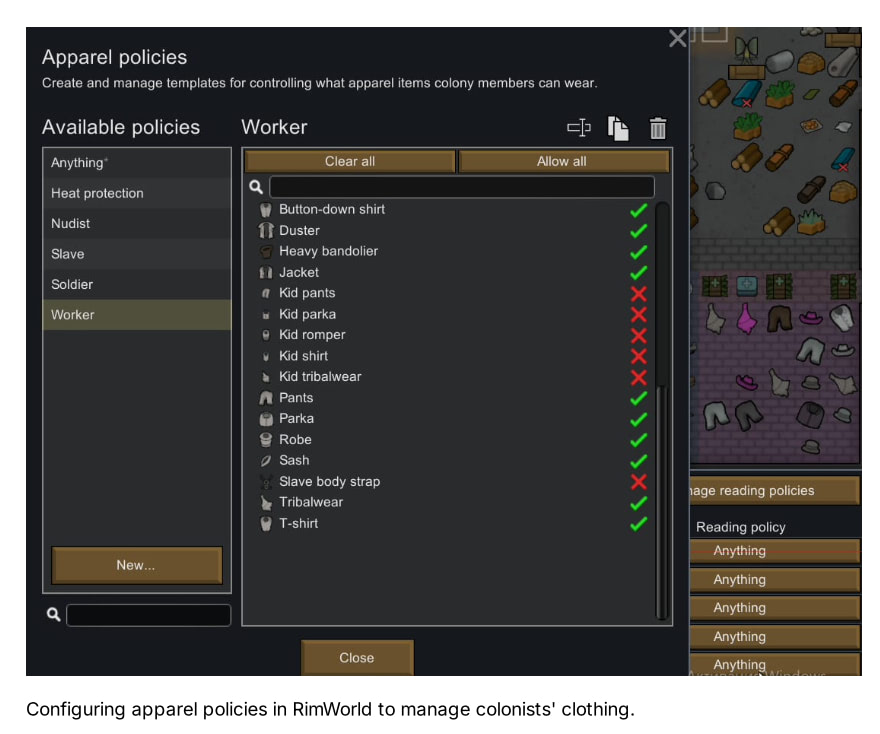
Configuring apparel policies in RimWorld to manage colonists' clothing - essential for maintaining proper cold weather gear!
Mid-Game Pro Tip
By the end of mid-game, ideally every colonist should have a decent parka (or equivalent) and tuque, plus backup apparel for when their main gear is being repaired or replaced. Store textiles in a temperature-controlled stockpile to prevent deterioration!
Late-Game & Advanced Cold-Climate Tactics ❄️
In late-game, your colony is well-established. You likely have high-tech resources, maybe some power armor, or fancy apparel. The challenges shift from simply surviving cold to optimizing for cold while maintaining maximum combat effectiveness and colony wealth.
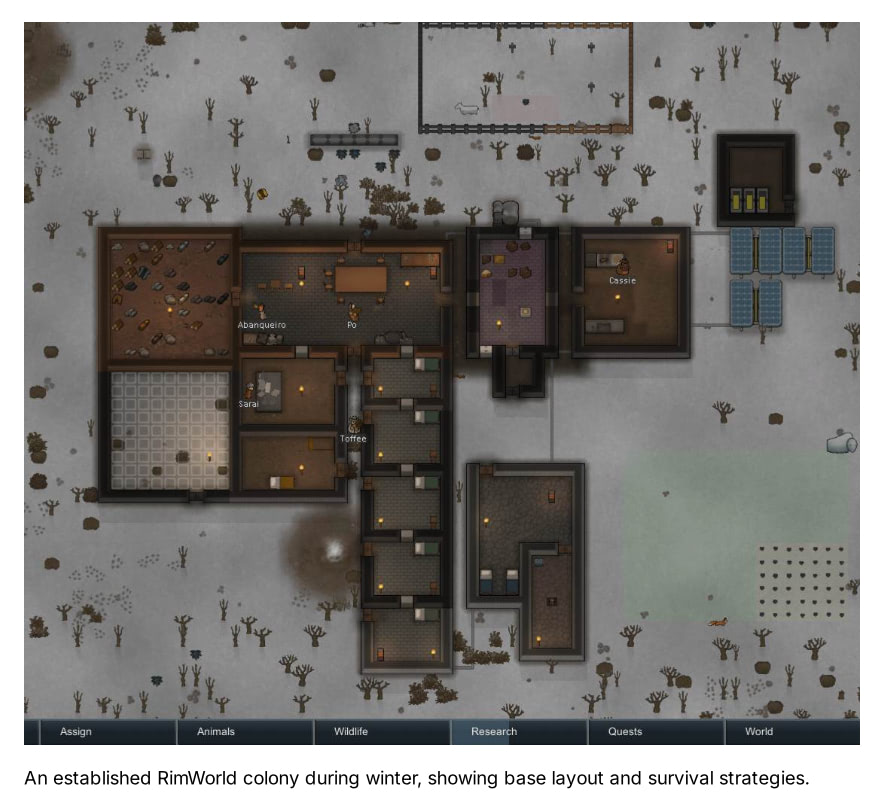
An established RimWorld colony during winter, showing base layout and survival strategies - this is what success looks like!
Power Armor vs. Parkas – Hybrid Approach
Late game often introduces Marine armor, Recon armor, and other advanced gear. These offer superior protection but poor insulation.
Armor Insulation
- Recon Armor: ~+5°C cold comfort
- Marine armor: ~+8-10°C cold protection
- Nowhere near a parka's insulation
Solutions
- Situational gear swapping (parkas → armor when raids come)
- Stockpile armor near defensive positions
- Place heaters in outdoor work areas and killboxes
Late-Game Heating Infrastructure
By late game you should have redundant heating and temperature control:
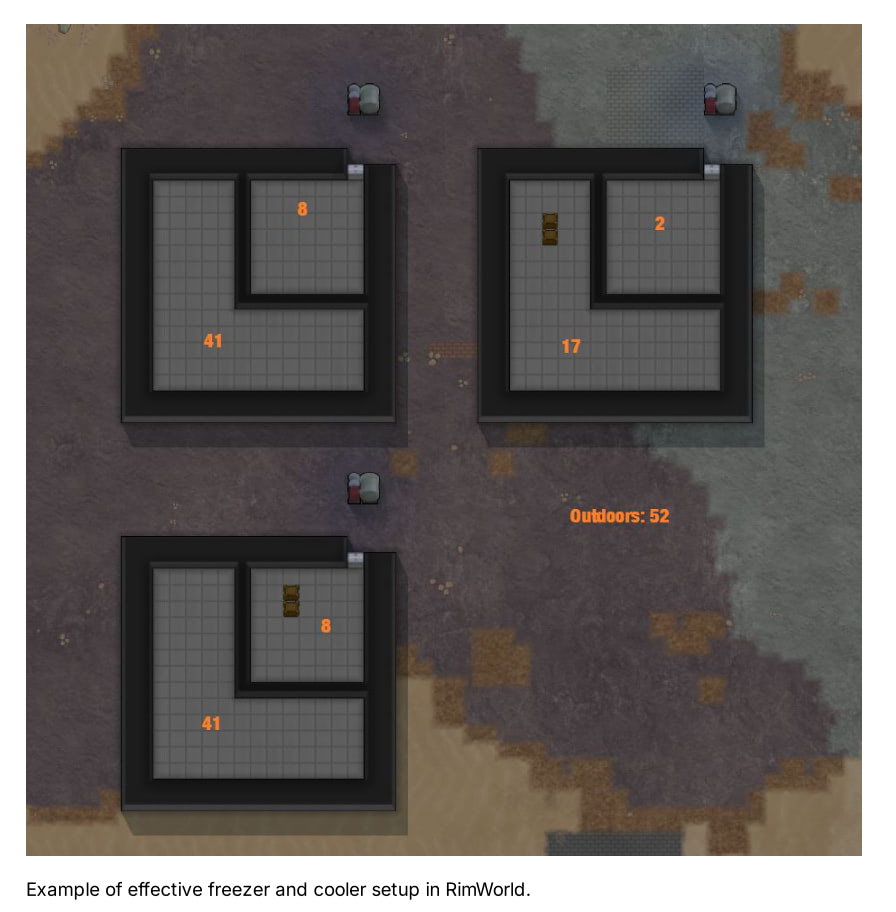
Example of effective freezer and cooler setup - proper temperature control is crucial for both food preservation and colonist comfort.
- Multiple heaters per room
- Backup power systems (solar + wind + geothermal)
- Heated pathways connecting buildings
- Double or triple-walled exteriors for insulation
- Roofed, heated walkways to distant work sites
For advanced temperature management techniques including airlock designs and efficient heating systems, see our temperature control guide.
Managing Caravans and Travel
Late game is when you might venture out for quests or to launch the ship:
- Always outfit caravans with the best cold-weather gear
- Pack cloth/leather bedrolls and wood/chemfuel for campfires
- Use drop pods to supply warm clothes if a cold snap hits
- Consider pod travel to reduce time in the elements
Utilizing New Technologies/Abilities
If you have the Biotech expansion, you might have genes that help with cold:
Cold-Resistant Genes
Some xenotypes have Furskin or Cold inclined genes making them naturally resistant to cold (about –10°C more comfortable).
Bionics
Bionic limbs don't get frostbite, so replacing vulnerable toes/fingers with bionics means no more losing them to the cold.
Children and Warm Clothes
By late game, you might have children in the colony (Biotech):
- Children cannot wear adult apparel until they hit teen years
- Craft Kids' parkas and kids' tuques at your tailoring bench
- Check outfit assignments for children - default might not allow kid clothes
- A well-dressed child in a wool kid-parka can survive just as well as adults
Style and Luxury
In late game you can afford to dress pawns in stylish apparel without compromising survival:
- Thrumbofur bowler hat + Arctic fox fur cape (Royalty DLC) can serve as stylish cold gear
- Use the dye system to color-code outfits by role or temperature
- Focus on getting Masterwork and Legendary apparel for significant comfort boosts
- A legendary muffalo wool parka provides an insane +100 °C cold insulation
Overcoming Extreme Biomes
If you're playing on Sea Ice or an Ice Sheet year-round, late game might still be –50 °C in summer:
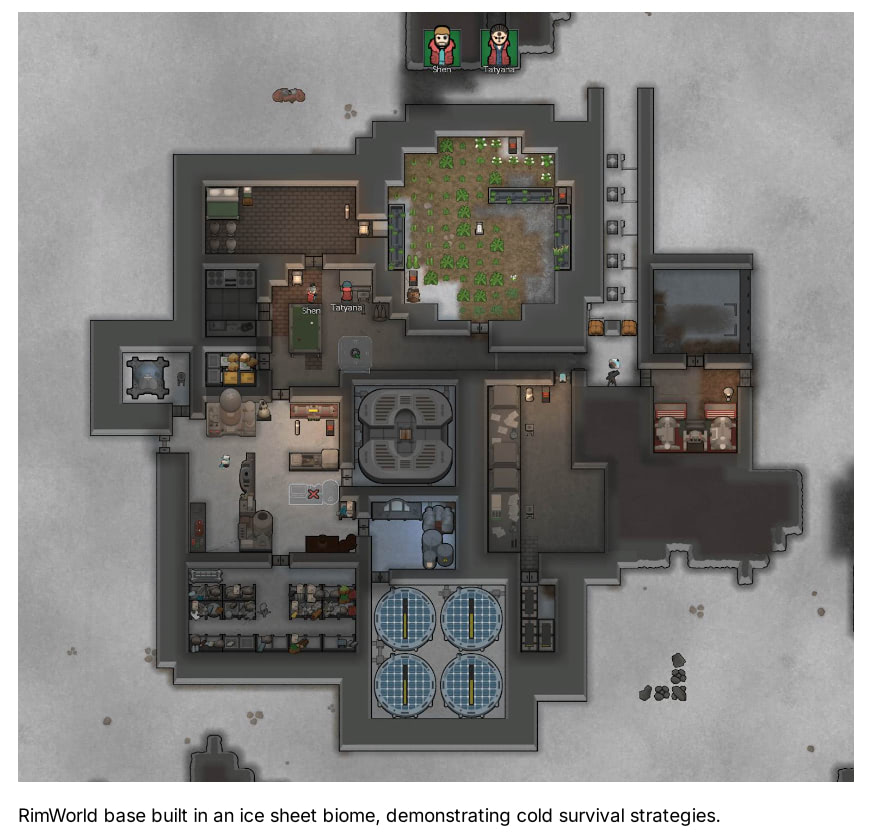
A RimWorld base built in an ice sheet biome - notice the compact, heated design essential for extreme cold survival.
- Double-walled, heated base
- Only go outside in pairs (so they can rescue each other)
- Use transport pods for anything beyond a few tiles of travel
- Keep everyone in top-tier parkas all the time
- Consider launching the ship or moving to a warmer tile as an end-game choice
Late-game cold survival becomes almost trivial with sufficient prep. You might find yourself with more parkas than you can ever wear (excellent trade goods!) and colonists who actually prefer the cold because they're so well-equipped. As a bonus, you won't have to worry about food spoilage – your whole map is basically a freezer year-round. 😄
Best Materials for Warm Clothing 🧵
Choosing the right material for your cold-weather gear can make an enormous difference. Some materials offer more than triple the insulation of others!
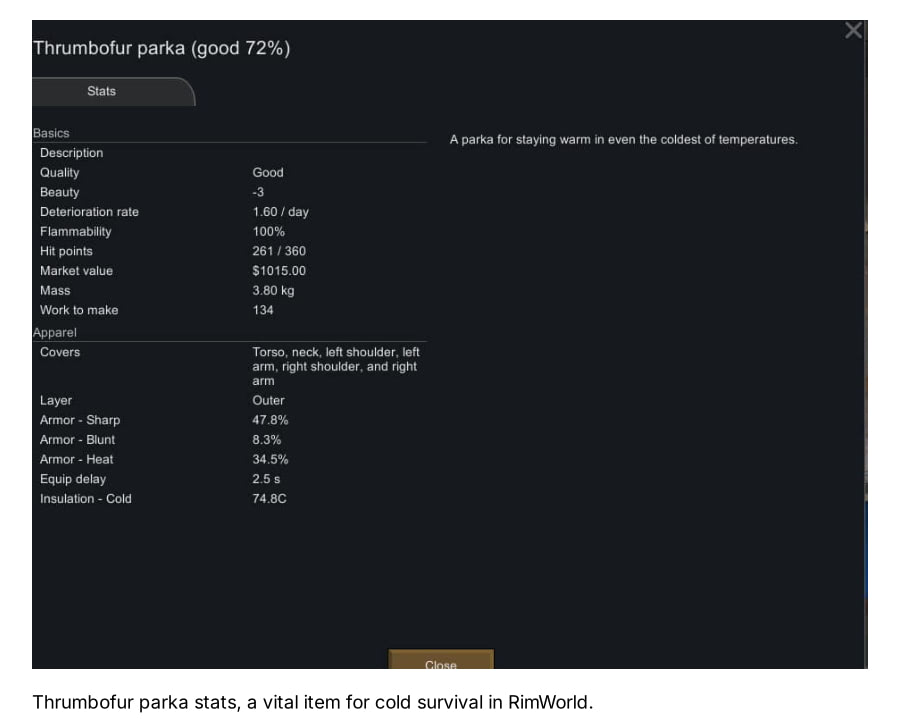
Thrumbofur parka stats showing the incredible cold insulation values - this is the gold standard for cold weather gear!
Temperature Calculator
See how different materials affect your pawn's temperature range:
Calculated Temperature Range:
Comfortable from -20°C to +30°C
Cold Insulation: +30°C
Top Insulating Materials Comparison
| Material | Cold Insulation | Heat Insulation | Sharp Armor | Notes |
|---|---|---|---|---|
| Guinea Pig Fur | +38°C | +20°C | 1.18× | Hard to get in bulk, requires many guinea pigs |
| Thrumbofur | +34°C | +26°C | 1.40× | Rare, excellent armor + insulation combination |
| Megasloth Wool | +34°C | +18°C | 1.10× | From hunting or taming megasloths |
| Chinchilla Fur | +30°C | +22°C | 1.15× | Requires a lot of chinchillas; small animals |
| Alpaca Wool | +30°C | +16°C | 1.15× | Great all-rounder; faster shearing than muffalo |
| Muffalo Wool | +30°C | +12°C | 1.05× | Common; muffalo are multipurpose ranch animals |
| Heavy Fur | +30°C | +10°C | 1.10× | From bears, polar wolves, etc. |
| Sheep Wool | +26°C | +14°C | 1.00× | Easy to ranch; decent insulation |
| Hyperweave | +26°C | +26°C | 1.60× | Spacer tech fabric; excellent balanced stats |
| Devilstrand | +20°C | +20°C | 1.50× | Growable; excellent armor; decent insulation |
| Cloth | +18°C | +18°C | 0.80× | Easily growable; decent basic insulation |
| Plainleather | +16°C | +16°C | 1.00× | Standard leather; readily available from hunting |
| Human Leather | +12°C | +12°C | 0.90× | Poor insulation; huge mood penalties for most pawns |
Material Selection Pro Tips
- Prioritize ranching wool-producing animals like alpacas or muffalo for a renewable source of top-tier insulating material
- Hunt for megasloths or thrumbos when possible - their materials offer the best cold protection in the game
- Quality matters! A legendary cloth parka can outperform a normal thrumbofur one due to the quality multiplier (1.8×)
- Consider your biome temperature range - don't waste thrumbofur on a temperate forest where cloth would suffice
- Balance insulation with other needs - devilstrand offers decent warmth plus excellent protection and durability
FAQ: Frosty Questions and Hot Answers 🔥
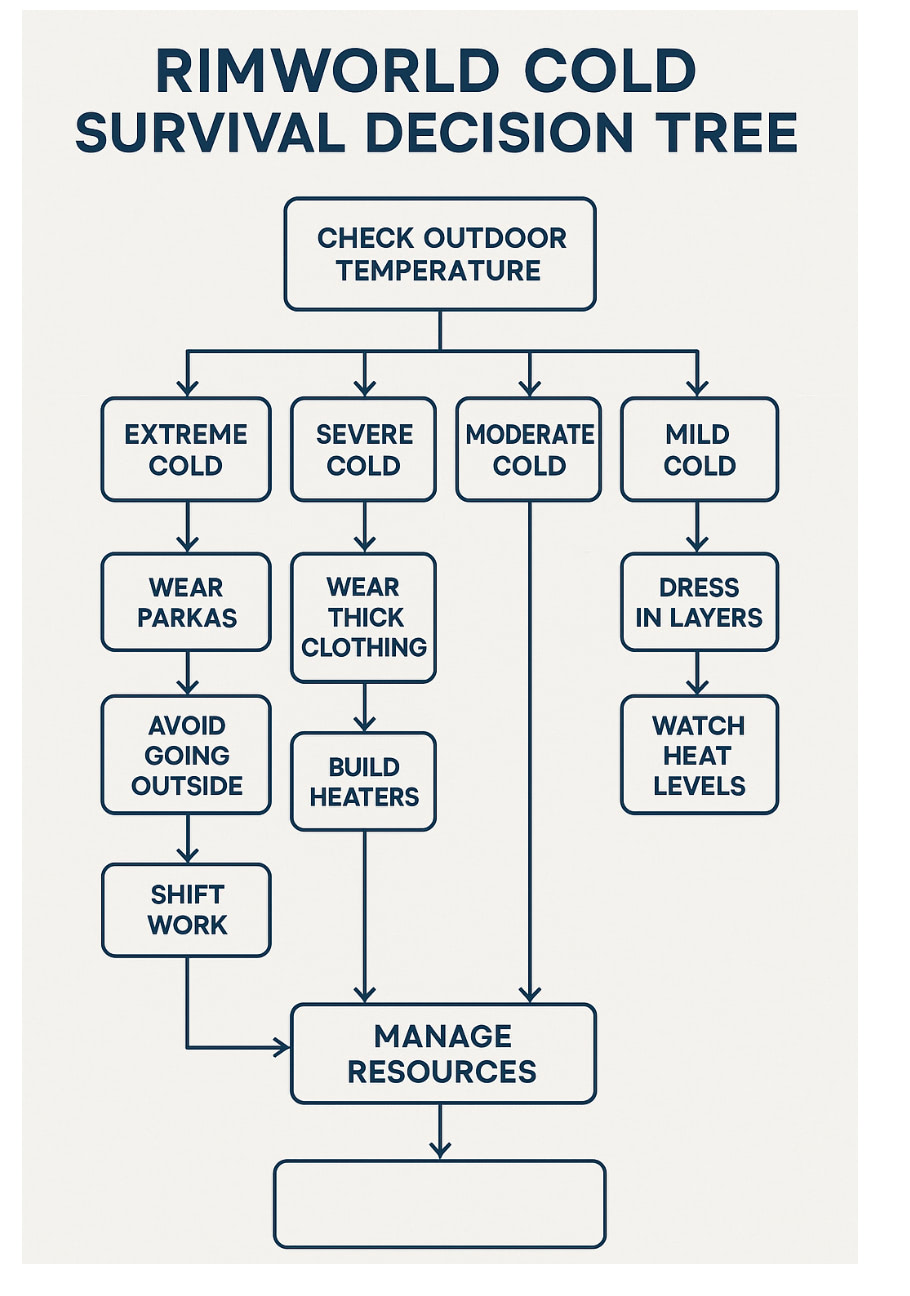
RimWorld Cold Survival Decision Tree - a quick reference flowchart to help you make the right choices when the temperature drops!
Are parkas really the only option for cold temperatures?
+For extreme cold (below –20 °C), basically yes – parkas are unparalleled. A good parka can more than triple a pawn's cold tolerance. Jackets and dusters just don't come close in frigid biomes.
However, in milder cold (0 to –10 °C or so), you can get away with layered clothing or dusters, especially if made of wool. Some players use devilstrand dusters + wool shirts to cover moderate cold and prefer the armor and leg coverage dusters give.
But if the temperature plummets, you'll see why parkas rule – those pawns in dusters will start shivering while parka-wearers are still "comfortable." So, parkas aren't the only option, but they are the best and often the required one in harsh winters.
One compromise some use is carrying a parka in inventory: wear a duster normally, and if a cold snap hits, swap to the parka. (This requires micromanagement since pawns won't auto-swap from inventory.)
What's the warmest material for clothing?
+The top contenders are Guinea pig fur and Thrumbofur. Guinea pig fur actually has the highest cold insulation (+38 °C) of any textile, but it's rare to get in bulk (needs a lot of guinea pigs 😅). Thrumbofur is a close second (+34 °C) and has fantastic armor ratings too – a thrumbofur parka or duster is end-game luxury gear.
Next tier includes Megasloth wool (+34 °C), Chinchilla fur (+30 °C), Alpaca wool (+30 °C), Heavy fur (+30 °C), Sheep wool (+26 °C). Plainleather, by contrast, is only +16 °C, and Human leather is downright terrible at insulating (+12 °C).
Quality matters: a Legendary heavy fur parka can out-insulate a normal thrumbofur one due to that 1.8x quality multiplier. So a skilled crafter can make even "mid-tier" materials perform like top-tier.
My pawn is a nudist – how can I keep them alive in a cold biome?
+Nudists get a mood buff from not wearing clothes, but that's cold comfort when the air hurts your skin. In vanilla, there's unfortunately no secret to this: a nudist will have to wear clothes in extreme cold or they'll die, buff or no buff.
You can mitigate mood loss by making the environment extremely nice (impressive barracks, fine meals, drugs, etc.) to offset the "Wearing clothes" mood hit they'll get.
Another approach is to limit their outdoor exposure to near zero – keep the nudist indoors in a heated area 100% of the time (essentially house arrest) during winter, and only let them streak outside when absolutely necessary.
If you have Ideology, you could give them a Burka or Cape of their ideoligion style – sometimes nudists don't mind ideologically mandated clothing.
One trick: you can set a nudist's outfit to only include tribalwear (which covers torso/legs minimally) so they at least have something. They'll still lose their nudist buff, but at least tribalwear+heater might keep them alive.
Is it worth heating my entire base, or just individual rooms?
+It's usually more efficient to heat key rooms (bedrooms, rec room, dining, workshop) and leave other areas cold. Colonists can traverse a cold hallway or stockpile briefly without trouble, as long as they warm up again.
Heating every single tile of your base wastes power – you'll need a ton of heaters. Instead, create warm "islands" where colonists spend most of their time. Use vents to connect rooms so a single heater can heat two bedrooms, for example.
Keep doors to the outside closed; consider double-door airlocks on frequently used entrances to avoid heat loss. Freezers can double as unheated buffers between outside and inside (just don't let pawns linger there). For detailed airlock designs and temperature management strategies, see our temperature control guide.
The only time you might heat an entire base is if you've built mostly indoors (mountain base) or you have excess power and want to avoid any micro. Some players on ice sheet effectively turn their entire base interior into one giant heated complex – that works, but it's resource-heavy.
Also, remember colonists get a mood buff for "Extremely comfortable" if their bedroom is a nice temperature (around 21 °C). So at least make bedrooms cozy; they'll thank you for it.
How do I deal with cold snaps in a normally mild biome?
+Cold snaps can catch you off guard in places like Temperate Forest or Arid Shrubland. Suddenly it's –5 °C when your colony was wearing t-shirts. The key is to have an emergency stash of parkas or jackets even if you normally don't need them.
The game does issue a "Cold snap" event warning, so as soon as you see that, activate your contingency:
- Assign everyone to the warm outfit (you did set one up, right?)
- Get fires or heaters going preemptively
- Harvest crops immediately (they're about to die anyway)
- Restrict vulnerable pawns indoors
Cold snaps usually last a few days; you can afford a short-term hit to productivity to keep everyone safe. If you have no spare clothes, time to improvise: make patchleather and sew tribalwear, slaughter livestock for leather, or even send a caravan to a neighboring settlement immediately to buy coats.
If you're desperate, have pawns huddle in a tight room with a campfire and wait it out. In a pinch, torches around sleeping spots can marginally raise temps.
Generally, a cold snap in a mild biome is a wake-up call to always have at least a couple parkas in your wardrobe. It's like keeping umbrellas for a rainy day.
Patch-History (Warm Clothing Changes)
Alpha 8 (Dec 2014) – "Winter is Coming" update
Parkas and Tuques added to the game, along with the cold biomes (Tundra, Ice Sheet) and hypothermia mechanics. This was the first introduction of dedicated warm clothes in RimWorld's history.
Beta 19/1.0 (Oct 2018) – Parka balancing
Removed the work speed and movement speed penalties from parkas. Up until this point, wearing a parka made pawns work 20% slower (to simulate bulkiness) and move –5% slower. The devs removed these penalties, making parkas strictly beneficial for insulation with no work trade-off.
Ideology DLC (July 2021)
Introduced Outfit Styles and dye system. Colonists developed style preferences (e.g. spikecore, morbid, etc.), and new apparel like Burkas and Hoods were added. Warm clothes can now be styled to fit an ideoligion.
Royalty DLC (Feb 2020)
Added noble apparel like the Cape and Prestige armor. Capes have about 0.8 insulation factor (like a fancy duster) and can be made of wool – a fur cape can keep a baron warm in style.
Biotech DLC (Oct 2022)
Introduced Children and child-sized apparel. Now you must craft Kid Parkas, Kid Tribalwear, etc., for your little ones. Also added genes like Cold Tolerant and Furskin which can modify a race's comfortable temperature range.
Update 1.5 (Oct 2024)
A small update primarily focused on performance and polish. Notably, it improved the performance of the "Need warm clothes" alert when you have massive amounts of clothing in stockpiles.